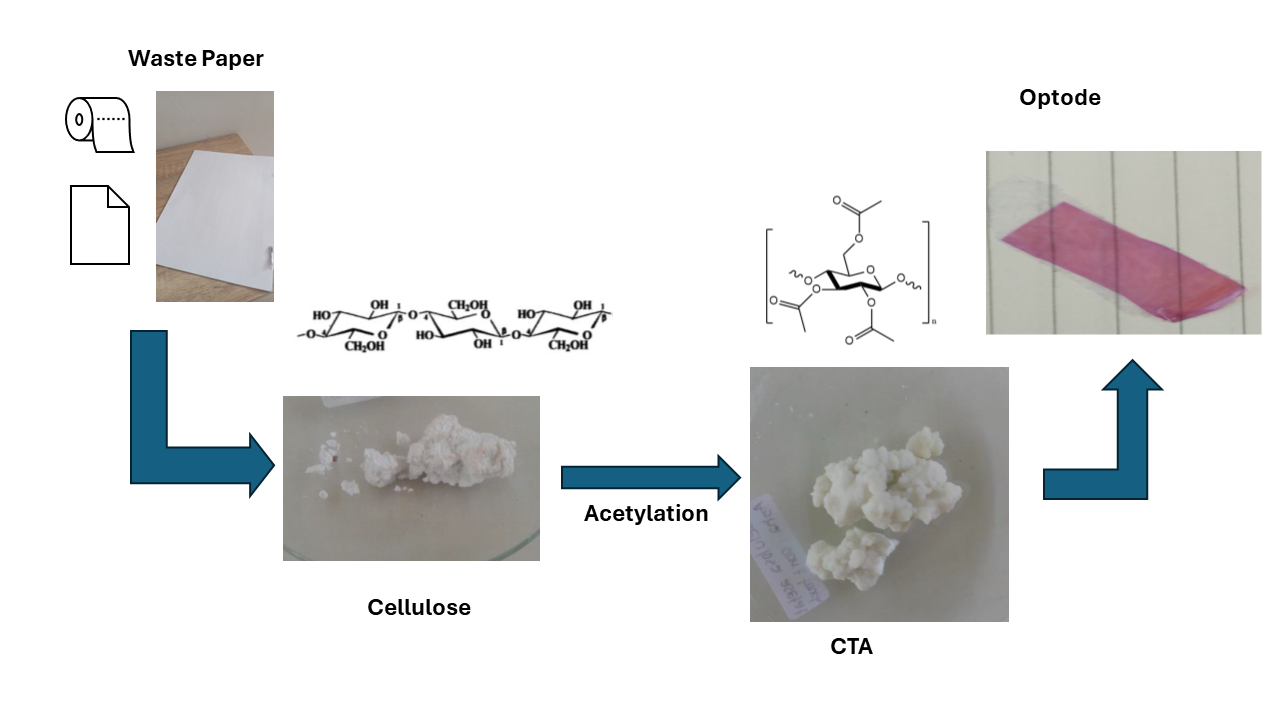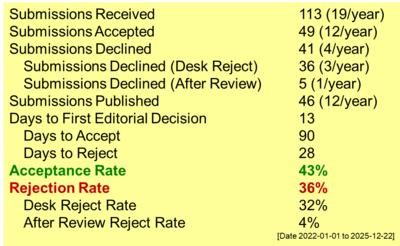Simple Synthesis of Cellulose Triacetate from HVS Paper Waste and Its Application for Optode
DOI:
https://doi.org/10.55749/ijcs.v3i1.46Keywords:
Cellulose triacetate, Degree of substitution, Hexavalent chromium, Optode, MembraneAbstract
The optode membrane is a membrane that can identify ions in an aqueous solution. One of the most widely used optode membranes is cellulose triacetate based. Cellulose triacetate (CTA) has the characteristics of hydrophobic, transparent, elastic, and affordable. There are sources of cellulose triacetate that can be utilized and waste paper is one of them. Waste paper is extracted to obtain the cellulose, then by acetylization reaction to produce cellulose triacetate. The resultant cellulose triacetate has a degree of substitution (DS) of 2.89 and an acetyl group percentage (% AG) of 43.64. The standard and synthesized CTA optode membrane are tested for performance with various parameters, ie optimum pH, optimum immersion time, working range, limit of detection (LOD), and limit of quantification (LOQ). The standard CTA optode membranes and synthesized worked at pH 3 and 4 with optimum immersion time for 15 min, respectively. The optode produced a linear response in detecting Cr(VI) ion in the concentration range of 0.02-1 mg/L for standard CTA with an R2 of 0.9726 and 1-25 mg/L for synthesized CTA with an R2 of 0.9764, The limit of detection (LOD) and limit of quantitation (LOQ) were 0.0015 mg/L and 0.0051 mg/L for standard CTA, while 0.0224 mg/L and 0.0749 mg/L for synthesis CTA respectively. Since both optode membranes' performance test results are adequate, the synthesis results of CTA optode membranes can be employed as one source of cellulose triacetate.
References
Sanchez, B., Wirosoedarmo, R., & Suharto, B. 2014. Analisis finansial sampah kertas di Universitas Brawijaya. J. Sumberdaya Alam dan Lingkungan. 1(2). 1–8.
Suah, F.B.M. 2017. Preparation and characterization of a novel Co(II) optode based on polymer inclusion membrane. Anal. Chem. Res. 12. 40–46. doi: 10.1016/j.ancr.2017.02.001.
Baezzat, M.R., & Karimi, M. 2013. Design and evaluation of a new optode based on immobilization of indophenol on triacetylcellulose membrane for determination of nickel. Int. J. Chem Tech Res. 5(5). 2503–2507.
Scindia, Y.M., Pandey, A.K., Reddy, A.V.R., & Manohar, S.B. 2004. Chemically selective membrane optode for Cr(VI) determination in aqueous samples. Anal. Chim. Acta. 515. 311–321. doi: https://doi.org/10.1016/j.aca.2004.03.074.
Filho, G.R., Monteiro, D.S., Meireles, C.S., Assuncao, R., Cerqueira, D.A., Barud, H.S., Ribeiro, S., & Messadeq, Y. 2008. Synthesis and characterization of cellulose triacetate produced from recycled newspaper. Carbohydrate Polymer. 73(1). 74–78. doi: https://doi.org/10.1016/j.carbpol.2007.11.010.
Beraich, F.Z., Arouch, M., Bakasse, M., & Nasrella, H. 2016. From waste to an ecological material : a new way to value the waste paper. IJISR. 20(2). 343–348.
Oliveira, H. 2012. Chromium as an environmental pollutant: insights on induced plant toxicity. J Botany. 375843. 1-8. doi: https://doi.org/10.1155/2012/375843.
Wiryawan, A., Suntari, R., Kusuma, Z., Retnowati, R., Burhan, R.Y.P., & Syekhfani. 2018. Method of analysis for determination of the chromium (Cr) species in water samples by spectrophotometry with diphenylcarbazide. Int. J. Chem Tech Res. 11 (01). 391–406.
Bello, A., Isa, M.T., Aderemi, B.O., Mukhtar, B. 2016. Acetylation of cotton stalk for cellulose triacetate production. ASRJET. 15(1). 137-150.
Fengel, D., Wegener, G, 1995. Wood Chemistry, Ultrastructure, Reactions. Berlin: Walter de gruyter & Co.
Li, F., Sun, M., Cheng, Q., Yang, B. 2016. Preparation and characterization of graphene oxide/cellulose triacetate forward osmosis membranes. MATEC Web Conf. 67. 1–6. doi: https://doi.org/10.1051/matecconf/20166.
Duffy, G., Maguire, I., Heery, B., Gers, P., Ducree, J., & Regan, F.. 2018. ChromiSense: A colourimetric lab-on-a-disc sensor for chromium speciation in water. Talanta. 178. 392-399. doi: 10.1016/j.talanta.2017.09.066.
Kong, F., Ni, Y. 2009. Determination of Cr(VI) concentration in diluted samples based on the paper test strip method. Water Sci. Tech. 60(12). 3083-3089. doi: https://doi.org/10.2166/wst.2009.741.
Association of Official Analytical Chemist. 2016. Official Method of Analysis of AOAC International 20th Ed. Washington: AOAC Pr.
Chikanbanjar, N., Semwal, N., Jyakhwa, U. 2020. A review article on analytical method validation. J. Pharm. Innov. 1(1). 48–58.
Arif, Z., Munandar, R., Rohaeti, E., Rafi, M. 2023. Detection of hexavalent chromium ion in water by optode membrane. Indones. J. Chem. Stud. 2(2). 76–82. doi: https://doi.org/10.5749/ijcs.v2i2.39.
Regulation of the Minister of Health of the Republic of Indonesia Number 492/MENKES/PER/IV/2010 about drinking water quality requirements in Indonesia, including maximum levels of various contaminants. Jakarta: Ministry of Health.
Regulation of Minister of Environment and Forestry of the Republic of Indonesia Number P.68/Menlhk.Setjen/Kum.1/8/2016 about Domestic Wastewater Quality Standards. Jakarta: Ministry of Environment and Forestry of the Republic of Indonesia.
Shaikh, H.M., Anis, A., Poulose, A.M., Al-Zahrani, S.M., Madhar, N.A., Alhamidi, A., Aldeligan, S.H., Alsubaie, F.S., 2022. Synthesis and characterization of cellulose triacetate obtained from date palm (Phoenix dactylifera L.) trunk mesh-derived cellulose. Molecules. 27(4). 1434. doi: https://doi.org/10.3390/molecules27041434.

Downloads
Published
How to Cite
Issue
Section
License
Copyright (c) 2024 Indonesian Journal of Chemical Studies

This work is licensed under a Creative Commons Attribution-ShareAlike 4.0 International License.






















